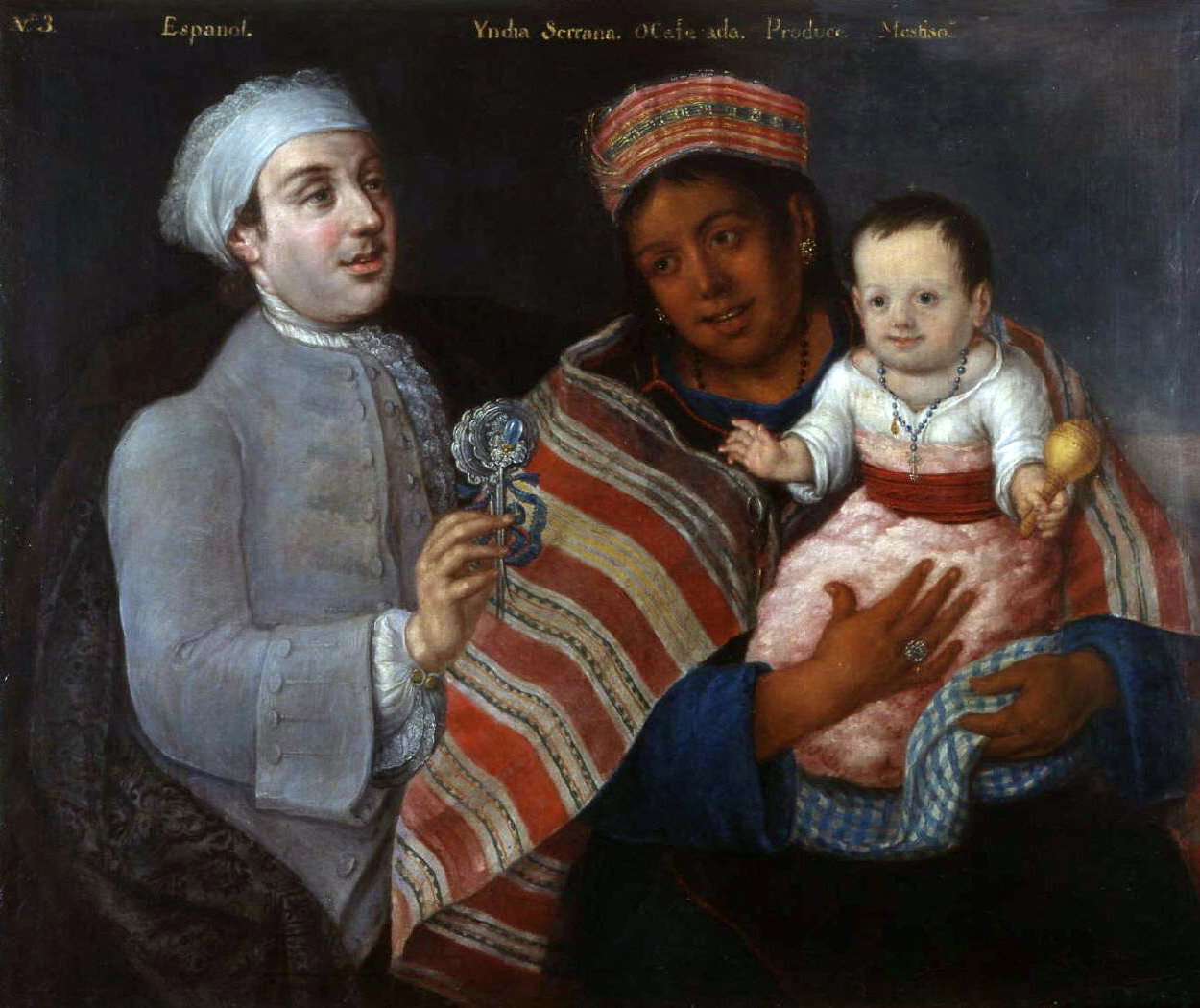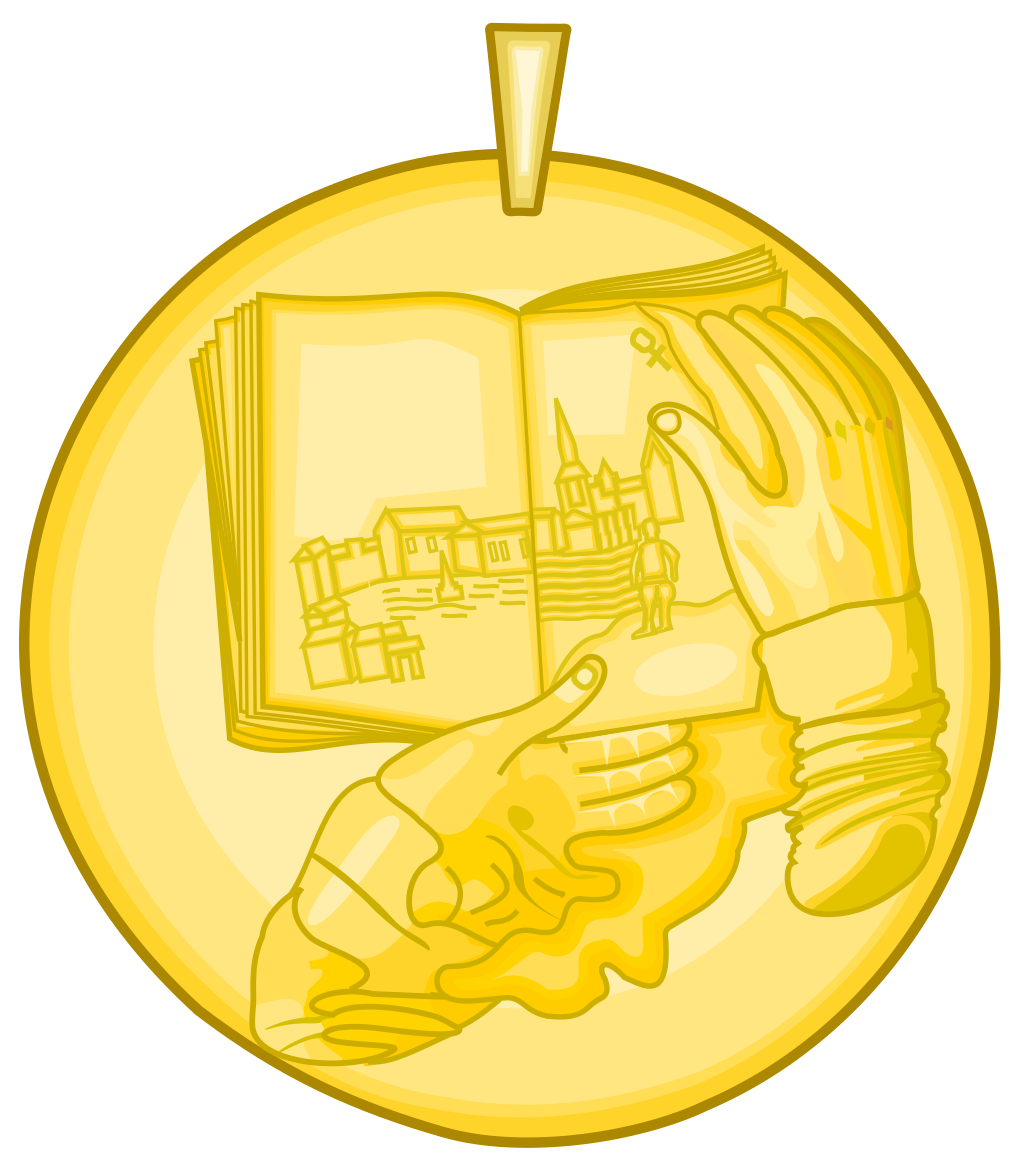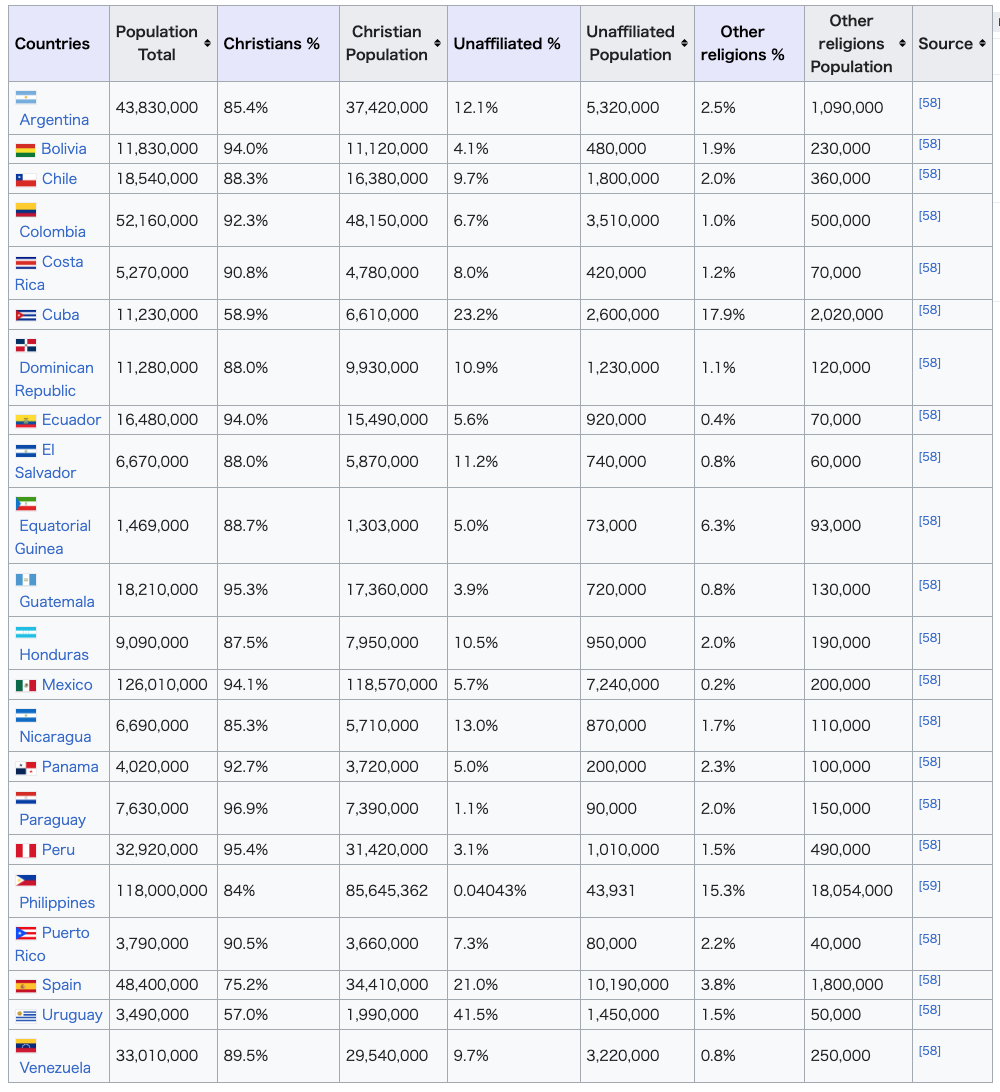イスパノアメリカ
Concepts on Hispano-America

イスパノアメリカ
Concepts on Hispano-America

池田光穂
★ラテンアメリカの代替物としての「ヒスパニック(Hispanic)」あるいは、イスパノアメ リカについて(→このページは「ラテンアメリカという概念」より派生しました)
ヒスパニック(スペイン語:hispano)という用語は、スペイン、スペイン語、またはヒ
スパニアに関連する人々、文化、国々を広く指す。特に米国では、文脈によっては「ヒスパニック」が民族または超民族的な用語として使用されることもある。
この用語は一般的に、スペイン人およびスペイン語話者(ヒスパニック語話者)の人口と、ヒスパニックアメリカ(大陸)およびヒスパニックアフリカ(赤道ギ
ニアおよび係争中の西サハラ地域)の国々を指す。これらの国々は、主に16世紀から20世紀にかけての植民地化により、かつてスペイン帝国の一部であっ
た。スペイン以外のヒスパニック語話者の国の文化は、先住のヒスパニック文化やその他の外国の影響も受けている。フィリピン、マリアナ諸島、その他の国々
を含む旧スペイン領東インドにもスペインの影響が見られる。しかし、これらの地域ではスペイン語は主要言語ではなく、その結果、これらの地域の住民は通
常、ヒスパニックとは見なされない。ヒスパニック文化とは、音楽、文学、服装、建築、料理など、ヒスパニック地域の人々が一般的に共有している習慣、伝
統、信念、芸術形態の集合体であるが、国や地域によって大きく異なる場合もある。スペイン語は、ヒスパニックの人々が共有する主な文化要素である。
| The term Hispanic (Spanish:
hispano) refers to people, cultures, or countries related to Spain, the
Spanish language, or Hispanidad broadly.[1][2] In some contexts,
especially within the United States, "Hispanic" is used as an ethnic or
meta-ethnic term.[3][4] The term commonly applies to Spaniards and Spanish-speaking (Hispanophone) populations and countries in Hispanic America (the continent) and Hispanic Africa (Equatorial Guinea and the disputed territory of Western Sahara), which were formerly part of the Spanish Empire due to colonization mainly between the 16th and 20th centuries. The cultures of Hispanophone countries outside Spain have been influenced as well by the local pre-Hispanic cultures or other foreign influences. There was also Spanish influence in the former Spanish East Indies, including the Philippines, Marianas, and other nations. However, Spanish is not a predominant language in these regions and, as a result, their inhabitants are not usually considered Hispanic. Hispanic culture is a set of customs, traditions, beliefs, and art forms in music, literature, dress, architecture, cuisine, and other cultural fields that are generally shared by peoples in Hispanic regions, but which can vary considerably from one country or territory to another. The Spanish language is the main cultural element shared by Hispanic peoples.[5][6] |
ヒスパニック(スペイン語:hispano)という用語は、スペイン、
スペイン語、またはヒスパニアに関連する人々、文化、国々を広く指す。[1][2]
特に米国では、文脈によっては「ヒスパニック」が民族または超民族的な用語として使用されることもある。[3][4] この用語は一般的に、スペイン人およびスペイン語話者(ヒスパニック語話者)の人口と、ヒスパニックアメリカ(大陸)およびヒスパニックアフリカ(赤道ギ ニアおよび係争中の西サハラ地域)の国々を指す。これらの国々は、主に16世紀から20世紀にかけての植民地化により、かつてスペイン帝国の一部であっ た。スペイン以外のヒスパニック語話者の国の文化は、先住のヒスパニック文化やその他の外国の影響も受けている。 フィリピン、マリアナ諸島、その他の国々を含む旧スペイン領東インドにもスペインの影響が見られる。しかし、これらの地域ではスペイン語は主要言語ではな く、その結果、これらの地域の住民は通常、ヒスパニックとは見なされない。 ヒスパニック文化とは、音楽、文学、服装、建築、料理など、ヒスパニック地域の人々が一般的に共有している習慣、伝統、信念、芸術形態の集合体であるが、 国や地域によって大きく異なる場合もある。スペイン語は、ヒスパニックの人々が共有する主な文化要素である。[5][6] |
| Terminology The term Hispanic derives from the Latin word Hispanicus, the adjectival derivation of Hispania, which means of the Iberian peninsula and possibly Celtiberian origin.[7] In English the word is attested from the 16th century (and in the late 19th century in American English).[8] The words Spain, Spanish, and Spaniard are of the same etymology as Hispanus, ultimately.[7]  Bust of a young Hispano-Roman man, 2nd century. Hispanus was the Latin name given to a person from Hispania during Roman rule. The ancient Roman Hispania, which roughly comprised what is currently called the Iberian Peninsula, included the contemporary states of Spain, Portugal, parts of France, Andorra, and the British Overseas Territory of Gibraltar.[9][10][11] In English, the term Hispano-Roman is sometimes used.[12] The Hispano-Romans were composed of people from many different Indigenous tribes, in addition to colonists from Italia.[13][14] Some famous Hispani (plural of Hispanus) and Hispaniensis were the emperors Trajan, Marcus Aurelius, Hadrian, Theodosius I and Magnus Maximus, the poets Marcus Annaeus Lucanus, Martial and Prudentius, the philosophers Seneca the Elder and Seneca the Younger, and the usurper Maximus of Hispania. A number of these men, such as Trajan, Hadrian and others, were in fact descended from Roman colonial families.[15][16][17] Here follows a comparison of several terms related to Hispanic: Hispania was the name of the Iberian Peninsula/Iberia from the 3rd century BC to the 8th AD, both as a Roman Empire province and immediately thereafter as a Visigothic kingdom, 5th–8th century. Hispano-Roman is used to refer to the culture and people of Hispania, both during the Roman period and subsequent Visigothic period.[18][19][20] Hispanic is used to refer to modern Spain, to the Spanish language, and to the Spanish-speaking nations of the world, particularly the Americas.[20][21] Spanish is used to refer to the people, nationality, culture, language and other things of Spain. Spaniard is used to refer to the people of Spain. Hispania was divided into two provinces: Hispania Citerior and Hispania Ulterior. In 27 BC, Hispania Ulterior was divided into two new provinces, Hispania Baetica and Hispania Lusitania, while Hispania Citerior was renamed Hispania Tarraconensis. This division of Hispania explains the usage of the singular and plural forms (Spain, and The Spains) used to refer to the peninsula and its kingdoms in the Middle Ages.[22] Before the marriage of Queen Isabella I of Castile and King Ferdinand II of Aragon in 1469, the four Christian kingdoms of the Iberian Peninsula—the Kingdom of Portugal, the Crown of Aragon, the Crown of Castile, and the Kingdom of Navarre—were collectively called The Spains. This revival of the old Roman concept in the Middle Ages appears to have originated in Provençal, and was first documented at the end of the 11th century. In the Council of Constance, the four kingdoms shared one vote. The terms Spain and the Spains were not interchangeable.[23] Spain was a geographic territory, home to several kingdoms (Christian and Muslim), with separate governments, laws, languages, religions, and customs, and was the historical remnant of the Hispano-Gothic unity.[24] Spain was not a political entity until much later, and when referring to the Middle Ages, one should not be confounded with the nation-state of today.[25] The term The Spains referred specifically to a collective of juridico-political units, first the Christian kingdoms, and then the different kingdoms ruled by the same king. Illustrative of this fact is the historical ecclesiastical title of Primate of the Spains, traditionally claimed by the Archbishop of Braga, a Portuguese prelate. With the Decretos de Nueva Planta, Philip V started to organize the fusion of his kingdoms that until then were ruled as distinct and independent, but this unification process lacked a formal and juridic proclamation.[26][27] Although colloquially and literally the expression "King of Spain" or "King of the Spains" was already widespread,[28] it did not refer to a unified nation-state. It was only in the constitution of 1812 that was adopted the name Españas (Spains) for the Spanish nation and the use of the title of "king of the Spains".[29] The constitution of 1876 adopts for the first time the name "Spain" for the Spanish nation and from then on the kings would use the title of "king of Spain".[30]  1770 painting of a mixed-race family from Spanish America. As a result of the significant mixing of populations during this time, the term "Hispanic" is often considered independent of racial background. The expansion of the Spanish Empire between 1492 and 1898 brought thousands of Spanish migrants to the conquered lands, who established settlements, mainly in the Americas, but also in other distant parts of the world (as in the Philippines, the lone Spanish territory in Asia), producing a number of multiracial populations. Today, the varied populations of these places, including those with Spanish ancestry, are also designated as Hispanic. Definitions in ancient Rome The Latin gentile adjectives that belong to Hispania are Hispanus, Hispanicus, and Hispaniensis. A Hispanus is someone who is a native of Hispania with no foreign parents, while children born in Hispania of Roman parents were Hispanienses. Hispaniensis means 'connected in some way to Hispania', as in "Exercitus Hispaniensis" ('the Spanish army') or "mercatores Hispanienses" ('Spanish merchants'). Hispanicus implies 'of' or 'belonging to' Hispania or the Hispanus or of their fashion as in "gladius Hispanicus".[31] The gentile adjectives were not ethnolinguistic but derived primarily on a geographic basis, from the toponym Hispania as the people of Hispania spoke different languages, although Titus Livius (Livy) said they could all understand each other, not making clear if they spoke dialects of the same language or were polyglots.[32] The first recorded use of an anthroponym derived from the toponym Hispania is attested in one of the five fragments, of Ennius in 236 BC who wrote "Hispane, non Romane memoretis loqui me" ("Remember that I speak like a Hispanic not a Roman") as having been said by a native of Hispania.[33][34] Definitions in Portugal, Spain, the rest of Europe In Portugal, Hispanic refers to something historical related to ancient Hispania (especially the terms Hispano-Roman and Hispania) or the Spanish language and cultures shared by all the Spanish-speaking countries.[35] Although sharing the etymology for the word (pt: hispânico, es: hispánico), the definition for Hispanic is different between Portugal and Spain. The Royal Spanish Academy (Spanish: Real Academia Española, RAE), the official royal institution responsible for regulating the Spanish language defines the terms "hispano" and "hispánico" (which in Spain have slightly different meanings) as:[36][37] Hispano: 1. A native of Hispania [Roman region] 2. Belonging or relating to Hispania 3. Spanish, as applied to a person 4. Of or pertaining to Hispanic America 5. Of or pertaining to the population of Hispanic American origin who live in the United States of America 6. A person of this origin who lives in the United States of America Hispánico 1. Belonging or relating to ancient Hispania or the people inhabiting the region 2. Belonging or relating to Spain and Spanish-speaking countries The modern term to identify Portuguese and Spanish territories under a single nomenclature is "Iberian", and the one to refer to cultures derived from both countries in the Americas is "Iberian-American". These designations can be mutually recognized by people in Portugal and Brazil. "Hispanic" is totally void of any self-identification in Brazil, and quite to the contrary, serves the purpose of marking a clear distinction in relation to neighboring countries' culture. Brazilians may identify as Latin Americans, but refute being considered Hispanics because their language and culture are neither part of the Hispanic cultural sphere, nor Spanish-speaking world. In Spanish, the term "hispano", as in "hispanoamericano", refers to the people of Spanish origin who live in the Americas and to a relationship to Spain or to the Spanish language. There are people in Hispanic America that are not of Spanish origin, such as Amerindians- the original people of these areas, as well as Africans and people with origins from other parts of Europe. Like in Portugal, in the rest of Europe (and wider world) the concept of 'Hispanic' refers to historical ancient Hispania (especially the term hispano-roman and Hispania during the Roman Empire) or the Spanish language and cultures shared by all the Spanish-speaking countries.[38][39][40][41] Definitions in the United States See also: Ethnic groups in the United States, History of Hispanic and Latino Americans, Race and ethnicity in the United States Census, and Hispanic and Latino (ethnic categories)  Hispanic boy from New Mexico, 1940 photograph. Both Hispanic and Latino are widely used in American English for Spanish-speaking people and their descendants in the United States. While Hispanic refers to Spanish speakers overall, Latino refers specifically to people of Latin American descent. Hispanic can also be used for the people and culture of Spain as well as Latin America.[42] While originally the term Hispanic referred primarily to the Hispanos of New Mexico within the United States,[43] today, organizations in the country use the term as a broad catchall to refer to persons with a historical and cultural relationship with Spain regardless of race and ethnicity.[5][6] The United States Census Bureau uses Hispanic or Latino to refer to a person of Cuban, Mexican, Puerto Rican, South or Central American, or other Spanish culture or origin regardless of race [44] and states that Hispanics or Latinos can be of any race and any ancestry.[45] Because of the technical distinctions involved in defining "race" vs. "ethnicity", there is confusion among the general population about the designation of Hispanic identity. Currently, the United States Census Bureau defines six race categories:[46] White or Caucasian Black or African American American Indian or Alaska Native Asian Native Hawaiian or Other Pacific Islander Some Other Race A 1997 notice by the U.S. Office of Management and Budget defined Hispanic or Latino persons as being "persons who trace their origin or descent to Mexico, Puerto Rico, Cuba, Central and South America, and other Spanish cultures."[47] The United States Census uses the ethnonyms Hispanic or Latino to refer to "a person of Cuban, Mexican, Puerto Rican, South or Central American, or other Hispanic culture or origin regardless of race."[44] The 2010 census asked if the person was "Spanish/Hispanic/Latino". The United States census uses the Hispanic or Latino to refer to "a person of Cuban, Mexican, Puerto Rican, South or Central American, or other Spanish culture or origin regardless of race."[44] The Census Bureau also explains that "[o]rigin can be viewed as the heritage, nationality group, lineage, or country of birth of the person or the person's ancestors before their arrival in the United States. People who identify their origin as Hispanic, Latino or Spanish may be of any race."[48] The U.S. Department of Transportation defines Hispanic as, "persons of Mexican, Puerto Rican, Cuban, Central or South American, or other Spanish culture or origin, regardless of race."[5] This definition has been adopted by the Small Business Administration as well as by many federal, state, and municipal agencies for the purposes of awarding government contracts to minority owned businesses.[6] The Congressional Hispanic Caucus and the Congressional Hispanic Conference include representatives of Spanish and Portuguese, Puerto Rican and Mexican descent. The Hispanic Society of America is dedicated to the study of the arts and cultures of the Hispanic and Lusitanic world.[49] The Hispanic Association of Colleges and Universities, proclaimed champions of Hispanic success in higher education, is committed to Hispanic educational success in the United States, and the Hispanic and Lusitanic world. The U.S. Equal Employment Opportunity Commission encourages any individual who believes that he or she is Hispanic to self-identify as Hispanic.[50] The United States Department of Labor – Office of Federal Contract Compliance Programs encourages the same self-identification. As a result, individuals with origins to part of the Spanish Empire may self-identify as Hispanic, because an employer may not override an individual's self-identification.[51] The 1970 census was the first time that a "Hispanic" identifier was used and data collected with the question. The definition of "Hispanic" has been modified in each successive census.[52] In a recent study, most Spanish-speakers of Spanish or Hispanic American descent do not prefer the term Hispanic or Latino when it comes to describing their identity. Instead, they prefer to be identified by their country of origin. When asked if they have a preference for either being identified as Hispanic or Latino, the Pew study finds that "half (51%) say they have no preference for either term."[53] Among those who do express a preference, "'Hispanic' is preferred over 'Latino' by more than a two-to-one margin—33% versus 14%." 21% prefer to be referred to simply as "Americans". A majority (51%) say they most often identify themselves by their family's country of origin, while 24% say they prefer a pan-ethnic label such as Hispanic or Latino.[54] |
用語 ヒスパニックという用語は、ラテン語のHispanus(ヒスパニアの形容詞形)に由来し、イベリア半島、おそらくケルトイベリア語族に由来するものであ る。英語では、この語は16世紀から使用されている(アメリカ英語では19世紀後半から)。 スペイン、スペイン語、スペイン人の語源は、最終的にはHispanusと同じである。  2世紀の若いヒスパノ・ローマ人の胸像 Hispanusは、ローマ帝国支配下のヒスパニア出身者に与えられたラテン語名である。古代ローマのヒスパニアは、現在のイベリア半島にほぼ相当し、ス ペイン、ポルトガル、フランスの一部、アンドラ、イギリスの海外領土であるジブラルタルを含んでいた。英語では、ヒスパノ・ローマという用語が時折使用さ れる。ヒスパノ・ローマ人は、多くの異なる先住民族の部族に加え、イタリアからの植民者で構成されていた イタリアからの入植者もいた。[13][14] 有名なヒスパニア人(Hispanusの複数形)およびヒスパニアネンシスには、トラヤヌス、マルクス・アウレリウス、ハドリアヌス、テオドシウス1世、 マグヌス・マクシムスといった皇帝、マルクス・アンナエウス・ルカヌス、マルティアル、プルデンティウスといった詩人、セネカ(大)、セネカ(小)といっ た哲学者、そしてヒスパニアの簒奪者マキシマスなどがいる。トラヤヌス、ハドリアヌスなど、これらの人物の多くは、実際にはローマの植民地出身の家系で あった。[15][16][17] 以下に、ヒスパニックに関連するいくつかの用語の比較を示す。 ヒスパニア(Hispania)は、紀元前3世紀から西暦8世紀にかけて、ローマ帝国の属州およびその後すぐに西ゴート王国の領土となったイベリア半島/ イベリアの名称であった。 ヒスパノ・ローマ(Hispano-Roman)は、ローマ時代およびその後の西ゴート時代におけるヒスパニアの文化および人々を指すために用いられる。 ヒスパニックは、現代のスペイン、スペイン語、および世界のスペイン語圏の国々、特にアメリカ大陸を指すために使用される。 スペイン語は、スペインの人々、国籍、文化、言語、その他のものを指すために使用される。 スペイン人は、スペインの人々を指すために使用される。 ヒスパニアは、ヒスパニア・キテリオールとヒスパニア・ウルテリオールの2つの属州に分割された。紀元前27年、ヒスパニア・ウルテリオルはヒスパニア・ バエティカとヒスパニア・ルシタニアの2つの新しい属州に分割され、ヒスパニア・シテリオルはヒスパニア・タラコネンシスと改名された。このヒスパニアの 分割は、中世において半島とその王国を指す際に用いられた単数形と複数形(スペイン、およびスペイン諸国)の用法を説明するものである。 1469年のカスティーリャ女王イザベル1世とアラゴン王フェルナンド2世の結婚以前は、イベリア半島の4つのキリスト教王国、ポルトガル王国、アラゴン 連合王国、カスティーリャ王国、ナバラ王国は、まとめてスペインと呼ばれていた。中世におけるこの古代ローマの概念の復活は、プロヴァンス語に由来するも ので、11世紀末に初めて文書に記録されている。コンスタンス公会議では、4つの王国は1票の権利を有していた。 スペインとスペイン諸国という用語は、互換性のあるものではなかった。[23] スペインは地理的な領土であり、複数の王国(キリスト教とイスラム教)が存在し、それぞれに政府、法律、言語、宗教、習慣が異なっていた。また、これはヒ スパノ・ゴート族の統一の歴史的残存物でもあった。[24] スペインは、 政治的な実体となったのはずっと後のことであり、中世について言及する際には、今日の国民国家と混同してはならない。[25] 「スペイン」という用語は、特に法政政治単位の集合体を指し、最初はキリスト教王国、次に同じ王によって統治された異なる王国を指した。この事実を示す例 として、ポルトガルの高位聖職者であるブラガ大司教が伝統的に主張してきた「スペインの首位司教」という歴史的な教会称号がある。 フィリップ5世はヌエバ・プラタ勅令により、それまで別個に独立して統治されていた王国の統合を始めたが、この統一プロセスには正式な法的な宣言はなかっ た。[26][27] 口語的かつ文字通りに「スペイン王」または「スペインの王」という表現はすでに広まっていたが、[28] それは統一国家を指すものではなかった。スペイン国家を「エスパーニャ(スペイン)」と呼び、「スペイン王」の称号を用いるようになったのは、1812年 の憲法においてからである。[29] 1876年の憲法では、スペイン国家を「スペイン」と呼ぶ名称が初めて採用され、それ以降、国王は「スペイン王」の称号を用いるようになった。[30]  1770年に描かれたスペイン領アメリカにおける混血家族。この時代に人口が大きく混ざり合った結果、「ヒスパニック」という用語は人種的背景とは無関係 であるとみなされることが多い。 1492年から1898年にかけてのスペイン帝国の拡大により、征服地には数千人のスペイン人移住者が移り住み、主にアメリカ大陸、そしてアジアのフィリ ピンなど世界の遠隔地にも入植地を築き、多様な混血集団を生み出した。今日、これらの地域の多様な人々、スペイン系の人々も含めて、ヒスパニックと呼ばれ る。 古代ローマにおける定義 ヒスパニアに属するラテン語の異邦人形容詞は、Hispanus、Hispanicus、Hispaniensisである。Hispanusは、外国人の 親を持たないヒスパニアの原住民を指し、ヒスパニアでローマ人の親から生まれた子供はHispaniensisと呼ばれた。Hispaniensisは 「ヒスパニアと何らかのつながりがある」という意味であり、「Exercitus Hispaniensis」(スペイン軍)や「mercatores Hispanienses」(スペイン商人)のように用いられる。ヒスパニクスは「~の」または「~に属する」という意味であり、例えば「グラディウス・ ヒスパニクス」のように、ヒスパニアまたはヒスパヌス、あるいはその様式を意味する。[31] これらの民族形容詞は民族言語的なものではなく、主に地理的な基準に基づいており、ヒスパニアの人々は異なる言語を話していたが、ティトゥス・リウィウス (リウィウス)は彼らが互いに理解し合えると述べている。 方言なのか、それとも多言語話者なのかは明確ではない。[32] 地名Hispaniaに由来する人名が最初に記録されたのは、紀元前236年のエンニウスによる5つの断片のうちの1つで、Hispania出身者が 「Hispane, non Romane memoretis loqui me」(「私はローマ人ではなくヒスパニア人らしく話すことを覚えておきなさい」)と言ったとされている。[33][34] ポルトガル、スペイン、その他のヨーロッパにおける定義 ポルトガルでは、ヒスパニックという語は古代のヒスパニア(特にヒスパノ・ローマやヒスパニア)に関連する歴史的なもの、あるいはスペイン語を話す国々す べてに共通するスペイン語や文化を指す。語源(pt: hispânico、es: hispánico)はポルトガルとスペインで共通しているが、ヒスパニックの定義は両国で異なる。スペイン語の標準化を担う公式の王立機関であるスペイ ン王立アカデミー(スペイン語: Real Academia Española, RAE)は、「ヒスパノ(hispano)」と「ヒスパニコ(hispánico)」という用語(スペインでは若干異なる意味を持つ)を次のように定義し ている。 ヒスパノ: 1. 古代ローマの属州ヒスパニアの出身者 2. ヒスパニアに属する、またはヒスパニアに関係する 3. スペイン人、という意味で人に対して用いられる 4. ヒスパニック・アメリカ人、またはヒスパニック・アメリカ人に関係する 5. アメリカ合衆国に住むヒスパニック・アメリカ人の起源を持つ人々、またはそれらに関係する 6. アメリカ合衆国に住む、この起源を持つ人々 ヒスパニコ: 1. 古代のヒスパニアまたはその地域に居住する人々に関連する 2. スペインおよびスペイン語圏の国々に関連する ポルトガルとスペインの領土を単一の名称で表す現代的な用語は「イベリア」であり、両国から派生したアメリカ大陸の文化を指す用語は「イベリア・アメリ カ」である。これらの名称は、ポルトガルとブラジルの人々によって相互に認識されている。「ヒスパニック」という言葉はブラジルでは自己認識とは全く無縁 であり、むしろ近隣諸国の文化との明確な区別を目的として使用されている。ブラジル人は自らをラテンアメリカ人であると認識しているが、言語や文化がヒス パニック文化圏やスペイン語圏の一部ではないため、ヒスパニックであると見なされることを否定している。 スペイン語では、「ヒスパノ」という用語は「ヒスパノアメリカン」のように、アメリカ大陸に住むスペイン語を話す人々、またはスペインやスペイン語との関 係を指す。ヒスパニックアメリカには、スペイン語を話す人々以外にも、この地域の原住民であるアメリカインディアンやアフリカ人、ヨーロッパの他の地域出 身の人々などがいる。 ポルトガルと同様に、ヨーロッパ(およびより広い世界)では、「ヒスパニック」という概念は、古代のヒスパニア(特にローマ帝国時代のヒスパノ・ローマ人 およびヒスパニア)を指すか、またはスペイン語を話すすべての国々が共有するスペイン語や文化を指す。 アメリカ合衆国における定義 関連項目:アメリカ合衆国の民族、ヒスパニック系およびラテン系アメリカ人の歴史、アメリカ合衆国における人種と民族、ヒスパニック系およびラテン系(民 族カテゴリー)  ニューメキシコ州のヒスパニック系少年、1940年の写真。 アメリカ英語では、スペイン語話者およびその子孫を指す場合、ヒスパニック系(Hispanic)とラテン系(Latino)の両方が広く使用されてい る。ヒスパニック系はスペイン語話者全般を指すが、ラテン系は特にラテンアメリカ系の人々を指す。ヒスパニックという語は、スペインやラテンアメリカの人 々や文化に対しても用いられることがある。[42] 当初、ヒスパニックという語は主にアメリカ合衆国内のニューメキシコ州のヒスパノスを指していたが、[43] 現在では、アメリカ国内の組織では、人種や民族に関係なく、スペインとの歴史的・文化的関係を持つ人々を広く包括的に指す語として用いられている。。 [5][6] 米国勢調査局は、人種に関係なく、キューバ人、メキシコ人、プエルトリコ人、南米人、中米人、またはその他のスペイン文化圏の人々を指すために「ヒスパ ニックまたはラテン系」という用語を使用しており[44]、ヒスパニックまたはラテン系の人々は、あらゆる人種およびあらゆる祖先を持つ可能性があると述 べている。[45] 「人種」と「民族」の定義には技術的な違いがあるため、ヒスパニックとしてのアイデンティティの呼称については一般の人々の間でも混乱がある。現在、米国 勢調査局は6つの人種カテゴリーを定義している。[46] 白人またはコーカソイド 黒人またはアフリカ系アメリカ人 アメリカン・インディアンまたはアラスカ先住民 アジア人 ハワイ先住民またはその他の太平洋諸島系 その他の人種 1997年の米国行政管理予算局の通知では、ヒスパニックまたはラテン系の人々を「メキシコ、プエルトリコ、キューバ、中央アメリカ、南アメリカ、および その他のスペイン文化に起源または家系をたどることができる人々」と定義している[47]。米国国勢調査では、人種に関係なく「キューバ、メキシコ、プエ ルトリコ、南アメリカ、中央アメリカ、またはその他のヒスパニック文化や起源を持つ人々」を指すために、ヒスパニックまたはラテン系の民族名を使用してい る[44]。 2010年の国勢調査では、その人が「スペイン系/ヒスパニック系/ラテン系」であるかどうかを尋ねた。米国の国勢調査では、「人種に関係なく、キューバ 人、メキシコ人、プエルトリコ人、南米人、中米人、またはその他のスペイン文化圏出身者、あるいはスペイン語を話す人」を指す場合、「ヒスパニックまたは ラテン系」という表現が用いられる。[44] また、国勢調査局は、「出身地は、その人またはその人の祖先が米国に到着する前の遺産、国籍グループ、家系、出生国として見なすことができる。ヒスパニッ ク、ラテン系、スペイン系を出自とする人々は、あらゆる人種である可能性がある」[48] 米国運輸省はヒスパニックを「人種に関係なく、メキシコ系、プエルトリコ系、キューバ系、中央アメリカ系、南アメリカ系、またはその他のスペイン文化圏ま たはスペイン語を話す人々」と定義している。[5] この定義は、マイノリティが所有する企業に政府契約を授与する目的で、中小企業庁や多くの連邦、州、地方自治体の機関によって採用されている。[6] 連邦議会ヒスパニック議員連盟および連邦議会ヒスパニック会議には、スペイン語話者およびポルトガル語話者、プエルトリコ系およびメキシコ系の代表者が参 加している。アメリカ・ヒスパニック協会は、ヒスパニックおよびポルトガル語圏世界の芸術と文化の研究に専念している。[49] ヒスパニック系大学・カレッジ協会は、高等教育におけるヒスパニックの成功の擁護者であると宣言しており、米国およびヒスパニックおよびポルトガル語圏世 界におけるヒスパニックの教育的成功に専念している。 米国雇用機会均等委員会は、ヒスパニック系であると考える人に対して、自らをヒスパニック系と認識するよう奨励している。[50] 米国労働省の連邦契約遵守プログラム事務局も同様に、自らをヒスパニック系と認識するよう奨励している。その結果、スペイン帝国の一部に起源を持つ個人 は、自らをヒスパニック系と認識することが可能である。なぜなら、雇用主は個人の自己認識を覆すことはできないからである。[51] 1970年の国勢調査で初めて「ヒスパニック」という識別語が使用され、その質問に対するデータが収集された。「ヒスパニック」の定義は、その後の国勢調 査で修正されてきた。[52] 最近の研究では、スペイン語話者やスペイン語系アメリカ人の大半は、自分たちのアイデンティティを表現する際に「ヒスパニック」や「ラテン系」という用語 を好んで使用していない。むしろ、出身国で識別されることを好んでいる。ヒスパニックとラテンアメリカ系アメリカ人のどちらの呼称を好むかという質問に対 して、ピュー研究所の調査では、「半数の51%がどちらの呼称も好みではないと答えている」ことが分かった。[53] 好みを表明した人々の中で、「『ヒスパニック』という呼称を『ラテンアメリカ系』よりも好むと答えた人は33%で、『ラテンアメリカ系』の14%を2倍以 上も上回っている。21%は単に『アメリカ人』と呼ばれることを好む。大多数(51%)は、自分自身を最もよく表すのは家族の出身国であると答えている が、24%はヒスパニックやラテン系といった全民族的なラベルを好むと答えている。[54] |
| Culture The Miguel de Cervantes Prize is awarded to Hispanic writers, whereas the Latin Grammy Award recognizes Hispanic musicians, and the Platino Awards as given to outstanding Hispanic films. Music Main articles: Music of Spain, Music of Latin America, and Latin music (genre) Folk and popular dance and music also varies greatly among Hispanics. For instance, the music from Spain is a lot different from the Hispanic American, although there is a high grade of exchange between both continents. In addition, due to the high national development of the diverse nationalities and regions of Spain, there is a lot of music in the different languages of the Peninsula (Catalan, Galician and Basque, mainly). See, for instance, Music of Catalonia or Rock català, Music of Galicia, Cantabria and Asturias, and Basque music. Flamenco is also a very popular music style in Spain, especially in Andalusia. Spanish ballads "romances" can be traced in Argentina as "milongas", same structure but different scenarios. On the other side of the ocean, Hispanic America is also home to a wide variety of music, even though Latin music is often erroneously thought of, as a single genre. Hispanic Caribbean music tends to favor complex polyrhythms of African origin. Mexican music shows combined influences of mostly European and Native American origin, while traditional Northern Mexican music—norteño and banda— polka, has influence from polka music brought by Central European settlers to Mexico which later influenced western music. The music of Hispanic Americans—such as tejano music—has influences in rock, jazz, R&B, pop, and country music as well as traditional Mexican music such as Mariachi. Meanwhile, native Andean sounds and melodies are the backbone of Peruvian and Bolivian music, but also play a significant role in the popular music of most South American countries and are heavily incorporated into the folk music of Ecuador and the tunes of Colombia, and in Chile where they play a fundamental role in the form of the greatly followed nueva canción. In U.S. communities of immigrants from these countries it is common to hear these styles. Rock en español, Latin hip-hop, Salsa, Merengue, Bachata, Cumbia and Reggaeton styles tend to appeal to the broader Hispanic population, and varieties of Cuban music are popular with many Hispanics of all backgrounds. Literature Main article: Hispanic literature  Miguel de Cervantes Prize, most prestigious literary award in the Spanish language Spanish-language literature and folklore is very rich and is influenced by a variety of countries. There are thousands of writers from many places, and dating from the Middle Ages to the present. Some of the most recognized writers are: Spain: Miguel de Cervantes Saavedra, Lope de Vega, Calderón de la Barca, Federico García Lorca, Miguel de Unamuno, Philippines: Jose Rizal, Luis Rodriguez Varela, Jesus Balmori Mexico: Carlos Fuentes, Octavio Paz, Guatemala: Miguel Ángel Asturias, U.S.: George Santayana, Sabine Ulibarri, Cuba: José Martí, Colombia: Gabriel García Márquez, Rafael Pombo, Uruguay: Horacio Quiroga, Cristina Peri Rossi, Venezuela: Rómulo Gallegos, Nicaragua: Rubén Darío, Peru: Mario Vargas Llosa, Ciro Alegría Argentina: Luisa Valenzuela, Julio Cortázar, Jorge Luis Borges, Ernesto Sabato Honduras: Roberto Quesada, Chile: Pablo Neruda, Gabriela Mistral, Dominican Republic: Pedro Henríquez Ureña, Equatorial Guinea: Juan Tomás Ávila Laurel, Costa Rica: Joaquin Garcia Monge and Ecuador: Juan León Mera. Sports In the majority of the Hispanic countries, association football is the most popular sport. The men's national teams of Argentina, Uruguay and Spain have won the FIFA World Cup a total six times. The Spanish La Liga is one of the most popular in the world, known for FC Barcelona and Real Madrid. Meanwhile, the Argentine Primera División is one of the strongest leagues in the Americas. However, baseball is the most popular sport in some Central American and Caribbean countries (especially Cuba, Dominican Republic, Puerto Rico, and Venezuela), as well as in the diaspora in the United States. Notable Hispanic teams in early baseball are the All Cubans, Cuban Stars and New York Cubans. The Hispanic Heritage Baseball Museum recognizes Hispanic baseball personalities. Nearly 30 percent (22 percent foreign-born Hispanics) of MLB players today have Hispanic heritage. Several Hispanic sportspeople have been successful worldwide, such as Diego Maradona, Alfredo di Stefano, Lionel Messi, Diego Forlán, Fernando Torres, Xavi, Andrés Iniesta, Iker Casillas, Xabi Alonso (association football), Juan Manuel Fangio, Juan Pablo Montoya, Eliseo Salazar, Fernando Alonso, Marc Gené, Carlos Sainz Sr. and Carlos Sainz Jr. (auto racing), Ángel Nieto, Dani Pedrosa, Jorge Lorenzo, Marc Márquez, Marc Coma, Nani Roma (motorcycle racing), Emanuel Ginóbili, Pau Gasol, Marc Gasol (basketball), Julio César Chávez, Saúl Álvarez, Carlos Monzón (boxing), Miguel Indurain, Alberto Contador, Santiago Botero, Rigoberto Urán, Nairo Quintana (cycling), Roberto de Vicenzo, Ángel Cabrera, Sergio García, Severiano Ballesteros, José María Olazábal (golf), Luciana Aymar (field hockey), Rafael Nadal, Marcelo Ríos, Guillermo Vilas, Gabriela Sabatini, Juan Martín del Potro (tennis). Notable Hispanic sports television networks are ESPN Deportes, Fox Deportes and TyC Sports. Religion The Spanish and the Portuguese took the Catholic faith to their colonies in the Americas, Africa, and Asia; Catholicism remains the predominant religion amongst most Hispanics.[55] A small but growing number of Hispanics belong to a Protestant denomination. Hispanic Christians form the largest ethno-linguistic group among Christians in the world, about 18% of the world's Christian population are Hispanic (around 430 millions).[56] In the United States, some 65% of Hispanics and Latinos report themselves Catholic and 21% Protestant, with 13% having no affiliation.[57] A minority among the Catholics, about one in five, are charismatics. Among the Protestant, 85% are "Born-again Christians" and belong to Evangelical or Pentecostal churches. Among the smallest groups, less than 4%, are Jewish.  Christianity The image of Our Lady of the Pillar wearing her canonical crown Among the Spanish-speaking Catholics, most communities celebrate their homeland's patron saint, dedicating a day for this purpose with festivals and religious services. Some Spanish-speakers in Latin America syncretize Roman Catholicism and African or Native American rituals and beliefs. Such is the case of Santería, popular with Afro-Cubans, which combines old African beliefs in the form of Roman Catholic saints and rituals. Other syncretistic beliefs include Spiritism and Curanderismo.[60] In Catholic tradition, Our Lady of the Pillar is considered the Patroness of the Hispanic people and the Hispanic world.[61] Islam While a tiny minority, there are some Muslims in Latin America, in the United States,[62] and in the Philippines. Those in the Philippines live predominantly in Bangsamoro.[63] Judaism There are also Spanish-speaking Jews, most of whom are the descendants of Ashkenazi Jews who migrated from Europe (German Jews, Russian Jews, Polish Jews, etc.) to Hispanic America, particularly Argentina, Uruguay, Peru, and Cuba (Argentina is host to the third-largest Jewish population in the Western Hemisphere, after the United States and Canada)[64][65] in the 19th century and following World War II. Many Spanish-speaking Jews also originate from the small communities of reconverted descendants of anusim—those whose Spanish Sephardi Jewish ancestors long ago hid their Jewish ancestry and beliefs in fear of persecution by the Spanish Inquisition in the Iberian Peninsula and Ibero-America. The Spanish Inquisition led to many forced conversions of Spanish Jews. Genetic studies on the (male) Y-chromosome conducted by the University of Leeds in 2008 appear to support the idea that the number of forced conversions have been previously underestimated significantly. They found that twenty percent of Spanish males have Y-chromosomes associated with Sephardic Jewish ancestry.[66] This may imply that there were more forced conversions than was previously thought. There are also thought to be many Catholic-professing descendants of marranos and Spanish-speaking crypto-Jews in the Southwestern United States and scattered through Hispanic America. Additionally, there are Sephardic Jews who are descendants of those Jews who fled Spain to Turkey, Syria, and North Africa, some of whom have now migrated to Hispanic America, holding on to some Spanish/Sephardic customs, such as the Ladino language, which mixes Spanish, Hebrew, Arabic and others, though written with Hebrew and Latin characters.[67] Ladinos were also African slaves captive in Spain held prior to the colonial period in the Americas. (See also History of the Jews in Hispanic America and List of Hispanic American Jews.) |
文化 ミゲル・デ・セルバンテス賞はスペイン語圏の作家に、ラテン・グラミー賞はスペイン語圏の音楽家に、プラティーノ賞は優れたスペイン語圏の映画に贈られ る。 音楽 主な記事:スペインの音楽、ラテンアメリカの音楽、ラテン音楽(ジャンル) 民族舞踊や民族音楽も、スペイン語圏の間で大きく異なる。例えば、スペインの音楽は、スペイン語圏のアメリカ大陸の音楽とは大きく異なるが、両大陸の間で は高度な交流がある。さらに、スペインの多様な民族や地域が高度に発展しているため、半島内のさまざまな言語(主にカタルーニャ語、ガリシア語、バスク 語)による音楽も数多く存在する。例えば、カタルーニャ音楽やカタルーニャ語のロック、ガリシア音楽、カンタブリア音楽、アストゥリアス音楽、バスク音楽 などがある。フラメンコはスペイン、特にアンダルシア地方で非常に人気の高い音楽スタイルである。スペインのバラード「ロマンセ」はアルゼンチンで「ミロ ンガ」として、同じ構造ながら異なるシナリオで存在している。 海の向こう側では、ラテンアメリカもまた多種多様な音楽の故郷である。ラテン音楽はしばしば誤って単一のジャンルとして考えられているが、実際にはそうで はない。 カリブ海のラテン音楽は、アフリカ起源の複雑なポリリズムを好む傾向がある。メキシコ音楽は主にヨーロッパとネイティブアメリカンの影響が融合したものと なっているが、北部メキシコの伝統音楽であるノルテーニョやバンダには、中欧からの入植者によってメキシコにもたらされたポルカ音楽の影響が見られ、それ が後に西洋音楽にも影響を与えた。 テハーノ音楽などのヒスパニック系アメリカ人の音楽には、マリアッチなどの伝統的なメキシコ音楽だけでなく、ロック、ジャズ、R&B、ポップ、カ ントリーミュージックなどの影響も見られる。一方、アンデス地方の土着の音やメロディはペルーやボリビアの音楽の基盤となっているが、南米のほとんどの国 のポピュラー音楽でも重要な役割を果たしており、エクアドルのフォーク音楽やコロンビアの楽曲にも多く取り入れられている。また、チリでは「ヌエバ・カン シオン」という形で重要な役割を果たしている。これらの国々からの移民が暮らす米国のコミュニティでは、これらのスタイルを耳にすることは一般的である。 ロック・エン・エスパニョール、ラテン・ヒップホップ、サルサ、メレンゲ、バチャータ、クンビア、レゲトンなどのスタイルは、より幅広いヒスパニック系住 民にアピールする傾向があり、キューバ音楽のさまざまなスタイルは、あらゆる背景を持つ多くのヒスパニック系住民に人気がある。 文学 詳細は「ヒスパニック文学」を参照  スペイン語圏で最も権威のある文学賞であるミゲル・デ・セルバンテス賞 スペイン語圏の文学や民話は非常に豊富であり、さまざまな国々から影響を受けている。中世から現在に至るまで、多くの地域から何千もの作家が輩出されてい る。最も著名な作家の一部は以下の通りである。 スペイン:ミゲル・デ・セルバンテス・サアベドラ、ロペ・デ・ベガ、カルデロン・デ・ラ・バルカ、フェデリコ・ガルシア・ロルカ、ミゲル・デ・ウナムノ、 フィリピン:ホセ・リサール、ルイス・ロドリゲス・バレラ、ヘスス・バルモリ メキシコ:カルロス・フエンテス、オクタビオ・パス グアテマラ:ミゲル・アンヘル・アストゥリアス 米国:ジョージ・サンタヤーナ、サビーン・ウリバリー キューバ:ホセ・マルティ コロンビア:ガブリエル・ガルシア・マルケス、ラファエル・ポンボ ウルグアイ:オラシオ・キロガ、クリスティーナ・ペリ・ロッシ ベネズエラ:ロムロ・ガレゴス ニカラグア:ルベン・ダリオ ペルー:マリオ・バルガス・リョサ、シロ・アレグリア アルゼンチン:ルイサ・バレヌエバ、フリオ・コルタサル、ホルヘ・ルイス・ボルヘス、エルネスト・サバト ホンジュラス:ロベルト・ケサダ、 チリ:パブロ・ネルーダ、ガブリエラ・ミストラル、 ドミニカ共和国:ペドロ・エンリケス・ウレーニャ、 赤道ギニア:フアン・トマス・アビラ・ラウレル、 コスタリカ:ホアキン・ガルシア・モンヘ、 エクアドル:フアン・レオン・メラ。 スポーツ スペイン語圏のほとんどの国々では、サッカーが最も人気のあるスポーツである。アルゼンチン、ウルグアイ、スペインの男子サッカー代表チームは、FIFA ワールドカップで合計6回の優勝を果たしている。スペインのリーガ・エスパニョーラは、FCバルセロナやレアル・マドリードで知られる世界でも最も人気の あるリーグのひとつである。一方、アルゼンチンのプリメーラ・ディビシオンは、アメリカ大陸で最も強いリーグのひとつである。 しかし、野球は中米やカリブ海諸国(特にキューバ、ドミニカ共和国、プエルトリコ、ベネズエラ)や、米国在住のディアスポラの間では最も人気のあるスポー ツである。初期の野球における著名なヒスパニック系チームには、オール・キューバンズ、キューバン・スターズ、ニューヨーク・キューバンズなどがある。ヒ スパニック・ヘリテージ・ベースボール・ミュージアムでは、ヒスパニック系の野球選手を称えている。現在、MLB選手の約30パーセント(22パーセント は外国生まれのヒスパニック系)がヒスパニック系である。 ディエゴ・マラドーナ、アルフレド・ディ・ステファノ、リオネル・メッシ、ディエゴ・フォルラン、フェルナンド・トーレス、チャビ、アンドレス・イニエス タ、イケル・カシージャス、シャビ・アロンソ(サッカー)、ファン・マヌエル・ファンジオ、ファン・パブロ・モントーヤ、エリセオ・サラザール、フェルナ ンド・アロンソ、マーク・ジェネ、カルロス・サインツ・シニア 、カルロス・サインツ・ジュニア(カーレース)、アンヘル・ニエト、ダニ・ペドロサ、ホルヘ・ロレンソ、マルク・マルケス、マルク・コマ、ナニ・ローマ (オートバイレース)、エマニュエル・ジノビリ、パウ・ガソル、マルク・ガソル(バスケットボール)、フリオ・セサール・チャベス、サウル・アルバレス、 カルロス・モンソン(ボクシング)、ミゲル・インドゥライン、アルベルト・コンタドール アドルフォ・コンタドール、サンティアゴ・ボテロ、リゴベルト・ウラン、ナイロ・キンタナ(自転車競技)、ロベルト・デ・ビセンゾ、アンヘル・カブレラ、 セルヒオ・ガルシア、セベ・バレステロス、ホセ・マリア・オラサバル(ゴルフ)、ルシアナ・アヤマール(フィールドホッケー)、ラファエル・ナダル、マル セロ・リオス、ギジェルモ・ビラス、ガブリエラ・サバティーニ、フアン・マルティン・デル・ポトロ(テニス)。 著名なヒスパニック系スポーツテレビ局には、ESPN Deportes、Fox Deportes、TyC Sportsがある。 宗教 スペイン人とポルトガル人は、アメリカ、アフリカ、アジアの植民地にカトリックの信仰をもたらした。カトリックは、ほとんどのヒスパニックの間で主流の宗 教であり続けている。[55] ヒスパニックのプロテスタント信者は少数派だが、その数は増加している。ヒスパニック系キリスト教徒は、世界中のキリスト教徒の中で最大の民族言語グルー プを形成しており、世界のキリスト教徒人口の約18%(約4億3000万人)を占めている。[56] 米国では、ヒスパニックおよびラテン系住民の約65%がカトリック教徒、21%がプロテスタント教徒と報告されており、13%は無宗教である。[57] カトリック教徒の少数派、約5人に1人はカリスマ派である。プロテスタント教徒の85%は「新生キリスト教徒」であり、福音派またはペンテコステ派の教会 に属している。最も少数派のグループはユダヤ教徒であり、4%未満である。  キリスト教 正規の冠を被った柱の聖母の像 スペイン語話者のカトリック教徒の間では、ほとんどのコミュニティが祖国の守護聖人を祝っており、そのために1日を祭りと宗教的儀式に充てている。ラテン アメリカの一部のスペイン語話者は、ローマ・カトリックとアフリカやアメリカ先住民の儀式や信仰を混ぜ合わせたものを受け入れている。例えば、アフリカ系 キューバ人に人気のサンテリアは、ローマ・カトリックの聖人や儀式の形をとった古いアフリカの信仰を組み合わせたものである。その他の混成信仰には、スピ リチュアリズムやクランデリスモなどがある。[60] カトリックの伝統では、柱の聖母はヒスパニック系の人々やヒスパニック系世界を守護する聖母とされている。[61] イスラム教 ラテンアメリカ、アメリカ合衆国、フィリピンには、ごく少数ではあるがイスラム教徒も存在する。フィリピンでは、主にバンサモロに住んでいる。[63] ユダヤ教 スペイン語を話すユダヤ人もおり、そのほとんどは、19世紀および第二次世界大戦後にヨーロッパ(ドイツ系ユダヤ人、ロシア系ユダヤ人、ポーランド系ユダ ヤ人など)からラテンアメリカ(特にアルゼンチン、ウルグアイ、ペルー、キューバ)に移住したアシュケナジム系ユダヤ人の子孫である。アルゼンチンには、 アメリカ大陸西部ではアメリカ合衆国、カナダに次いで3番目に大きなユダヤ人コミュニティがある。また、スペイン語を話すユダヤ人の多くは、アスィム(ア ンスィーム)として知られる改宗者の子孫である小規模なコミュニティに起源を持つ。アンスィームとは、イベリア半島およびイベロアメリカにおけるスペイン 異端審問による迫害を恐れて、ユダヤ人としての祖先や信仰を隠していたスペイン系セファルディムのユダヤ人の子孫である。スペイン異端審問により、多くの スペイン系ユダヤ人が改宗を余儀なくされた。 2008年にリーズ大学が実施した(男性の)Y染色体に関する遺伝学的研究は、強制改宗の数が以前に考えられていたよりもはるかに多いという考えを裏付け るものと思われる。 スペインの男性の20%がセファルディ系ユダヤ人の祖先と関連するY染色体を持っていることが判明した。[66] これは、強制改宗の数が以前に考えられていたよりも多いことを示唆している可能性がある。 また、南西部アメリカ合衆国には、カトリックを信仰するマラーノ(改宗ユダヤ人)の子孫やスペイン語を話す隠れユダヤ人が多くおり、ヒスパニック系アメリ カ中に散らばっていると考えられている。さらに、スペインからトルコ、シリア、北アフリカへと逃れたユダヤ人の子孫であるセファルディム系ユダヤ人もお り、その一部は現在ではヒスパニック系アメリカに移住し、スペイン語、ヘブライ語、アラビア語などが混ざったラディーノ語など、スペイン語/セファルディ ムの風習を保持している。ラディーノ語はヘブライ文字とラテン文字で表記されるが、[67] ラディーノはアメリカ大陸の植民地時代以前にスペインで捕らえられたアフリカ人奴隷でもあった。(ヒスパニック系アメリカにおけるユダヤ人の歴史およびヒ スパニック系アメリカ在住のユダヤ人の一覧も参照) |
| Spanish language Hispanophone Languages of Spain Spanish language in the Americas Spanish language in the United States Chavacano Latin Americans Afro-Latin American Amerindians Asian Latin American Criollo people Mestizo Mulatto White Latin American Isleño Americans Black Hispanic and Latino Americans White Hispanic and Latino Americans Hispanic America Hispanic Heritage Sites (U.S. National Park Service) Hispanic Paradox Cuban-American lobby Lusitanians Panhispanism Hispanism Flag of the Hispanic People Hispanophobia Culture of Spain Spanish Filipino Chavacano Philippine Spanish Hispanic influence on Filipino culture Emancipados Fernandinos Ibero-America (Iberian Peninsula) Latin Union |
スペイン語 スペイン語話者 スペインの言語 アメリカ大陸におけるスペイン語 アメリカ合衆国におけるスペイン語 チャバカノ語 ラテンアメリカ人 アフリカ系ラテンアメリカ人 アメリカインディアン アジア系ラテンアメリカ人 クリオーリョ人 メスティーソ ムラート 白人ラテンアメリカ人 イスレニョ人 黒人ヒスパニックおよびラテンアメリカ人 白人ヒスパニックおよびラテンアメリカ人 ヒスパニック系アメリカ ヒスパニック系遺産サイト(米国国立公園局) ヒスパニックのパラドックス キューバ系アメリカ人ロビー ルシタニア人 パン・アメリカニズム イスパニズム ヒスパニックの旗 ヒスパニック嫌い スペイン文化 スペイン語を話すフィリピン人 チャバカノ語 フィリピンスペイン語 フィリピン文化におけるヒスパニックの影響 エマンシパドス フェルナンディノス イベロ・アメリカ(イベリア半島) ラテン連合 |
| https://en.wikipedia.org/wiki/Hispanic |
|
リンク
文献
Copyleft,
CC, Mitzub'ixi Quq Chi'j, 1996-2099
☆
 ☆
☆